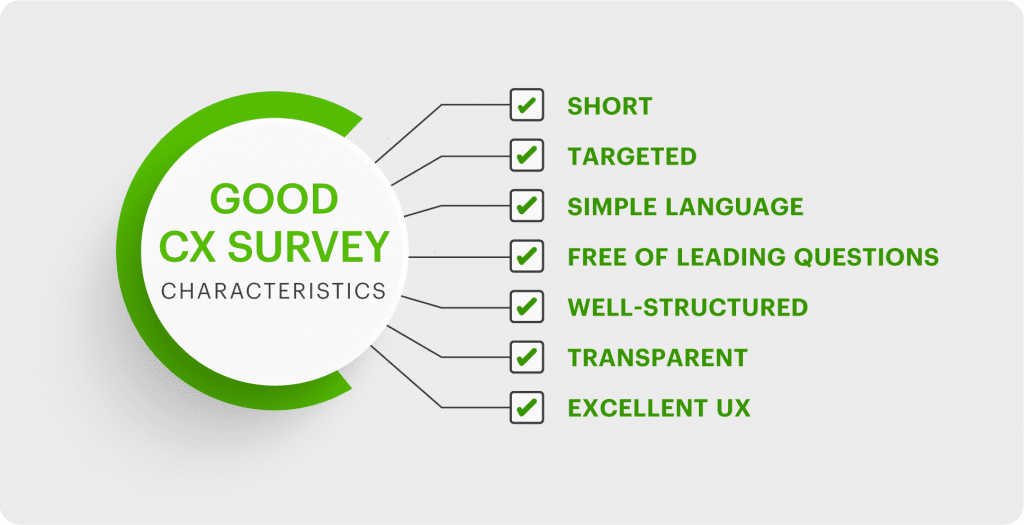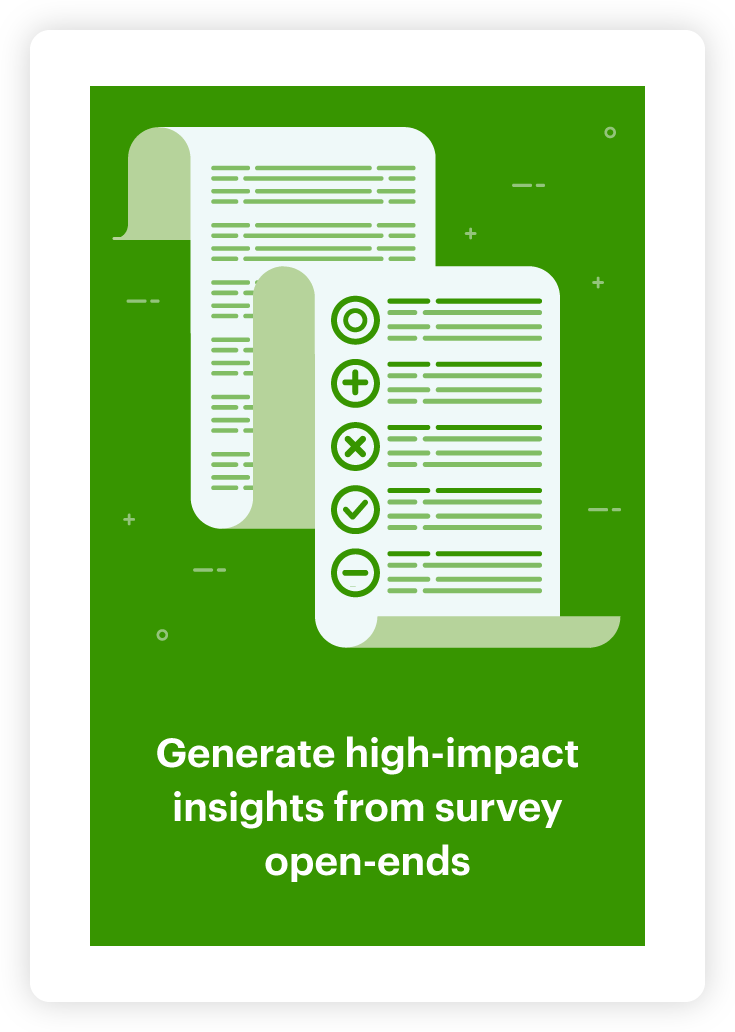Customer experience surveys: How to collect, analyze and act on customer feedback

A great product or service by itself is not enough to ensure customer loyalty. How do we know? 88% of customers say that the customer experience companies provide is as important as their products or services!
Unfortunately, this doesn’t change the sad reality that most businesses continue to fail to direct sufficient attention to excellent CX. Research conducted by ZenDesk has found that 87% of customers think brands need to put more effort into providing a seamless customer service experience.
The solution? Conducting regular customer experience surveys, building good processes for analyzing the results and incorporating feedback into all levels of decision-making.
As with any type of survey, there are many things you need to keep in mind when creating, disseminating and analyzing your next CX survey. In this article, we’ve broken down everything you need to know about customer satisfaction surveys:
- What is a customer satisfaction survey?
- What are the benefits of customer experience surveys?
- What makes a good customer experience survey?
- How to create a customer satisfaction survey
- Customer experience survey template
- What are the best survey companies?
- How do you run a customer experience survey?
- How to measure customer satisfaction – analyzing customer satisfaction survey results
- Building feedback loops with relevant stakeholders
What is a customer satisfaction survey?
Customer satisfaction surveys are questionnaires designed to help businesses pinpoint how customers think and feel about their brand, products and services. CX surveys allow you to measure and assess the current state of your customer experience in relation to customers’ expectations.
What are the benefits of customer experience surveys?
Providing your customers with an excellent CX without truly understanding their feelings and expectations? Impossible! This is why customer experience surveys are vital for any business looking to boost customer satisfaction and loyalty.
Among other things, customer surveys will help you:
- Assess your brand’s strengths and weaknesses
- Pinpoint areas in need of improvement
- Discover customers’ needs, wants and expectations
- Measure the success of CX initiatives over time
- Identify trends and patterns
- Set customer-focused business goals and priorities
- Boost customer happiness and retention
- Gain an edge over the competition
Customer experience survey best practices: What makes a good customer experience survey?
Having established the importance and benefits of CX surveys, let’s turn our attention to best practices for crafting your next customer experience survey in a way that is sure to generate high-impact insights.
Based on our experience working with hundreds of CX teams, we’ve boiled down the seven characteristics of a good CX survey:

- Short: Answering a survey requires effort. Once respondents have chosen to put in time and effort to answer your customer experience survey, don’t overwhelm them with an endless stream of questioning. Aim to keep your customer satisfaction questionnaire as concise and short as possible.
- Targeted: When creating your survey, be aware of who you are addressing. Make sure to match the survey format, layout and questions to the audience(s) you are targeting.
- Transparent: A major factor causing high survey drop-off rates? A lack of transparency! Respondents want to know how long the survey will take and have a progression bar showing their progress.
- Excellent UX: No matter how thoughtfully you design your survey, if respondents encounter slow loading times or other design or technical issues it is likely that they will quit answering questions. Your survey should be overall visually appealing to respondents to maintain engagement.
- Simple language: When crafting your survey questions, try to meet your customers where they are, considering aspects such as age, education level and subject matter understanding. As a rule of thumb, you should always try to keep the language as clear and simple as possible.
- Well-structured: Clearly structure your survey questions in line with the different subjects you want to address. Don’t try to mix different topics into one question, even if this means adding a few extra questions to your survey. Overpacking survey questions will only confuse your respondents and generate messy data that is difficult to analyze.
- Free of leading questions: Leading questions or questions with obviously positive or negative wording impose bias or hypotheses on respondents and should be avoided at all costs. Try to write exploratory open-ended questions that participants can answer in their own words instead – this is how you’ll get to the bottom of what customers truly think and feel.
How to create a customer satisfaction survey
It’s time to roll up your sleeves and start creating your customer experience survey!
Most likely you’re wondering: what questions should I ask in a customer experience survey? Don’t worry, we’ll get to this in just a minute.
But first, let’s take a step back…
Before you do anything else, ensure you have a clear understanding of the intended outcome of your customer experience survey. Ask yourself, what you would like to uncover, who your target audience is and how you plan on utilizing the insights you generate from the survey. These considerations will help shape the questions you choose to ask.
Surveys typically start by gathering demographic and behavioral information, such as name, location, occupation, products purchased, age or relationship status. Once you’ve crafted questions to capture the necessary data points needed to segment and analyze responses, you want to shift your focus to crafting customer experience questions.
Generally, there are two primary types of CX survey questions:
- Closed questions: Also called structured or quantitative questions, these types of questions prompt respondents to select from predetermined options such as yes/no, multiple choice and rating scales.
- Open-ended questions: Open-ends or qualitative questions allow respondents to express their thoughts and feelings in their own words and produce unstructured text data.
Because open-ended questions produce unstructured qualitative data, there’s been a historic tendency to focus surveys on quantitative or metrics-based questions that are easy to analyze. The problem is that closed questions only ever tell you half of the story – they often fail to reveal the drivers of customer opinions and ratings.
Customer surveys usually aim to address and measure particular aspects of CX, making use of one or multiple of the following metrics-based questions:
- Net promoter score (NPS): understand how likely a customer is to recommend your brand
- Customer satisfaction score (CSAT): assess customer satisfaction levels
- Customer effort score (CES): measure the amount of effort required by customers when having an interaction with your brand
- Likert scale: pinpoint degrees of customer (dis)agreement with particular statements
- Multiple choice: respondents select from a list of options
All of the above structured questions are tremendously useful and will help you pinpoint customers’ behavioral attributes, opinions and the current state of your company’s CX.
What they don’t tell you, is why customers made a particular selection or opted for a certain rating – this all-important why can only be revealed with the help of an accompanying open-ended question asking for the reason behind a selection. This is why it is paramount that you pair closed questions with open-ends when creating your customer experience survey.
Let’s look at some common customer experience survey examples to see how structured and open-ended questions can be used in tandem to yield powerful insights…
Customer experience survey template
Customer experience surveys are typically sent out during different stages of the customer journey when you believe your audience will be most likely to have opinions to share.
We know that creating a customer experience survey sounds easier in theory than it is in practice. This is why we’ve created the little book of survey templates, featuring short survey templates that center around different phases of the customer journey.
Gathering CX survey data: What are the best survey companies?
One of the many advantages of living in a digitalized world? You’re able to do almost anything online, including surveys! Online customer surveys have become the most popular, cost-effective and time-efficient way of gathering CX data.
But what are the best survey companies? According to G2 some of the top online customer survey tools for 2023 are:
- Qualtrics: Best for unified enterprise feedback collection and analysis, pushing the limits of traditional surveys with the power of AI.
- SurveyMonkey: Best for businesses looking for a simple user interface that doesn’t require much tech knowledge. It has a comprehensive free option.
- Google Forms: Best for running free surveys with responses added automatically to spreadsheets for further analysis.
- Zoho Survey: Best for a user-friendly interface, providing a rich array of features.
- Jotform: Best for creating surveys that specifically match your brand and embedding them directly into your website.
- QuestionPro: Best for quickly sending out and analyzing polls and quizzes, providing robust, shareable analytical reports.
- Typeform: Best for excellent UX, offering a unique and smooth interface that only shows one question at a time.
- SurveySparrow: Best for engaging, conversational surveys that provide a chat-like experience to respondents.
- Alchemer (formerly SurveyGizmo): Best for automation and filtering options, such as sending notifications and emails based on responses.
- Hubspot: All-in-one CRM that is best for companies looking to send out CX surveys to their entire customer database.
How do you run a customer experience survey?
You’ve crafted your survey questions and have chosen the online survey tool that’s best for you – great work! There are only a few more things you need to consider before launching your customer experience survey:
Determine when to send out your survey
As we’ve alluded to, it’s important to solicit responses when you believe your customers will be most likely to share their feedback. Customer journey mapping will help you identify touchpoints that have the highest impact on customer experience. Depending on your business goals and your audience, you might choose to send out different customer surveys periodically or only following specific customer behaviors.
One-time surveys are typically sent out shortly after customers perform certain actions, such as a first-time purchase, repeat purchases or following a return. Periodic CX surveys, on the other hand, might be sent out once a month, quarterly or annually to continuously track customer satisfaction. The latter is likely to be more useful when there is a clear and ongoing customer relationship as is often the case in B2B services.
Choose the appropriate channels for distribution
Where is your target audience most active and hence most likely to receive and respond to your survey?
Your answer to this question will determine the distribution channels for your customer experience survey. Common channels include:
- Social media
- SMS
- Company websites
- Mobile push notifications
- Tablets or touchscreens in-store
How to measure customer satisfaction – analyzing customer satisfaction survey results
You made it! By generating a customer experience survey in line with our tips and best practices, you’ve generated innumerous survey responses and are faced with mountains of customer feedback data.
Analyzing structured questions
Let’s begin with the easy part: your quantitative survey analysis. Most online survey tools automatically analyze your closed questions, providing you with a comprehensive overview of your quantitative insights.
If you’ve chosen to utilize NPS, CSAT or CES rating questions as a means of measuring CX, you’re probably eager to find out how to measure customer satisfaction using these metrics.
NPS questions work with a scale from 0 to 10 and measure promoters (ratings of 9 or 10), detractors (ratings of 6 or lower) and passives (ratings of 7 or 8). Your overall NPS is then calculated by subtracting the percentage of promoters from the percentage of detractors.
CSAT and CES survey questions both follow a 1 to 5 scale format. For CSAT, the percentage of respondents who are satisfied (4) and very satisfied (5) forms your CSAT score, while your CES score is measured by dividing the total number of customers who agree that their interaction was easy by the total number of responses.
Analyzing qualitative responses
So far so good. You’ve tackled the easy part. Your open-ended questions are where the challenge begins. If you choose the traditional approach of manually coding qualitative survey responses, you’ll spend days if not weeks reading and categorizing them into a set of predefined themes by hand. Clearly, this approach is not an effective use of time and resources. What’s more, manual survey analysis is often subjected to human error and bias, running the risk of being shaped by predetermined hypotheses.
The good news is that with survey data analysis software, the times of manual survey coding are over! Automated survey coding uses a combination of AI and natural language processing to speed up the analysis process, saving your insights team valuable time, money and resources while minimizing the potential for human bias and error. Survey data analysis software serves as an addition to your human insights team, allowing them to focus their efforts on strategizing and data-driven storytelling.
Utilizing a survey data analysis tool, you will be able to easily segment, analyze and compare your open-ends in line with different demographics, satisfaction scores, behavioral attributes or time periods. For example, you might want to understand how your products resonate with different demographic audience segments, which would lead you to segment your survey data in line with different generational groups to pinpoint similarities and differences.
Enhancing customer experience: Building feedback loops with relevant stakeholders
Now that you know everything there is to know about CX surveys, it’s time to use your survey insights to enhance customer experience.
But how do you present customer satisfaction survey results and integrate customer experience survey insights into all levels of decision-making? By building feedback loops with relevant stakeholders you can ensure a consistent flow of relevant insights and information to those who have the power to act on it. Stakeholder feedback loops are all about ensuring that the insights uncovered in your survey analysis are used to develop and execute an action plan. There exist multiple operational processes you can put in place to guarantee this happens:
- Identify your stakeholders and understand their needs
- Build trust by providing insights that are actionable, focused, authoritative and surprising
- Set up a cross-functional committee that is regularly briefed on customer experience survey results
- Share regular updates and develop an insights communication plan
Want to guarantee excellent CX and integrate customer feedback at all levels of decision-making? Book a no-commitment discovery call with one of our experts to learn how you can leverage your customer experience surveys to inspire stakeholders with actionable insights!
